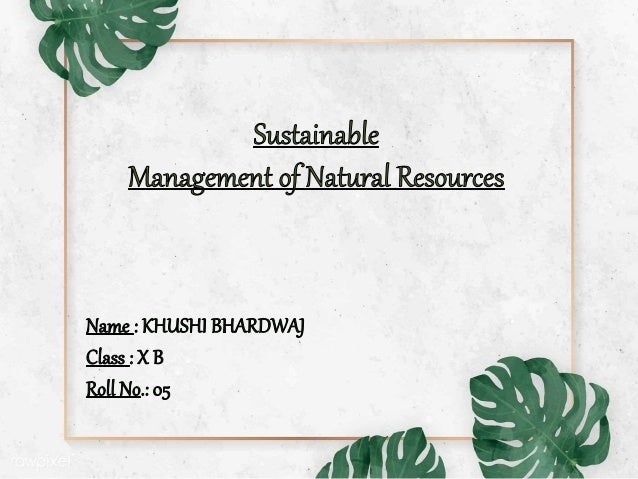Sustainable management of natural resources
- 2. Sustainable management of natural resources is defined in the Environment Act as: “using natural resources in a way and at a rate that maintains and enhances the resilience of ecosystems and the benefits they provide. In doing so, meeting the needs of present generations of people without compromising the ability of future generations to meet their needs, and contributing to the achievement of the well-being goals in the Well-being of Future Generations Act.” Natural resource management (NRM) is the management of natural resources such as land, water, soil, plants and animals, with a particular focus on how management affects the quality of life for both present and future generations (stewardship).natural resource management
- 3. Natural resource management specifically focuses on a scientific and technical understanding of resources and ecology and the life-supporting capacity of those resources. Environmental management is similar to natural resource management. Sustainable management takes the concepts from sustainability and synthesizes them with the concepts of management. Sustainability has three branches: the environment, the needs of present and future generations, and the economy. Using these branches, it creates the ability of a system to thrive by maintaining economic viability and also nourishing the needs of the present and future generations by limiting resource depletion. From this definition, sustainable management has been created to be defined as the application of sustainable practices in the categories of businesses, agriculture, society, environment, and personal life by managing them in a way that will benefit current generations and future generations.
- 4. The sustainable management of natural resources is an approach that asks us to consider ALL these benefits when we make decisions on how we manage our natural resources and ecosystems.
- 6. Management of the resources Natural resource management issues are inherently complex and contentious. First, they involve the ecological cycles, hydrological cycles, climate, animals, plants and geography, etc. All these are dynamic and inter-related. A change in one of them may have far reaching and/or long term impacts which may even be irreversible. Second, in addition to the complexity of the natural systems, managers also has to consider various stakeholders and their interests, policies, politics, geographical boundaries, and economic implications. It is impossible to fully satisfy all aspects at the same time. Therefore, between the scientific complexity and the diverse stakeholders, natural resource management is typically contentious. After the United Nations Conference for the Environment and Development (UNCED) held in Rio de Janeiro in 1992, most nations subscribed to new principles for the integrated management of land, water, and forests. Although program names vary from nation to nation, all express similar aims. The various approaches applied to natural resource management include: 1. Top-down (command and control) 2. Community-based natural resource management 3. Adaptive management 4. Precautionary approach 5. Integrated natural resource management 6. Ecosystem management
- 7. What action can I take to support the sustainable management of natural resources? Energy Efficiency and Renewable Energy The Welsh Government Energy Service provides support services to public sector and community organisations to identify, develop and deliver energy efficiency and renewable energy projects. Biodiversity Action for biodiversity should, as far as possible, be guided by the 6 objectives of the Nature Recovery Action Plan for Wales (NRAP8 ) which have been identified to contribute to reversing the decline of biodiversity in Wales. The 6 objectives to maintain and enhance biodiversity are: • Objective 1: Engage and support participation and understanding to embed biodiversity throughout decision making at all levels • Objective 2: Safeguard species and habitats of principal importance and improve their management • Objective 3: Increase the resilience* of our natural environment by restoring degraded habitats and habitat creation • Objective 4: Tackle key pressures on species and habitats • Objective 5: Improve our evidence, understanding and monitoring • Objective 6: Put in place a framework of governance and support for delivery.
- 8. Reduce, recycle and reuse The 3 Rs to save the environment can be performed by each individual in our society: Reduce: Reducing our usage and wasteful habits. Eg. not wasting food, turning off the switches to save electricity, repairing leaky taps, reducing the amount of water used for bathing, etc. Recycle: Collecting discarded paper, plastic, glass or metal objects to manufacture different products rather than synthesizing them from scratch. Must have a mechanism to segregate and dispose of each type of waste separately. Reuse: Using things again instead of discarding them. For example, reusing plastic utensils and bottles. Many things cannot be recycled or require a lot of energy, instead, we can utilize them for other purposes.








